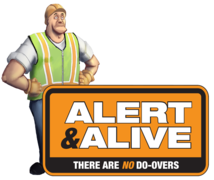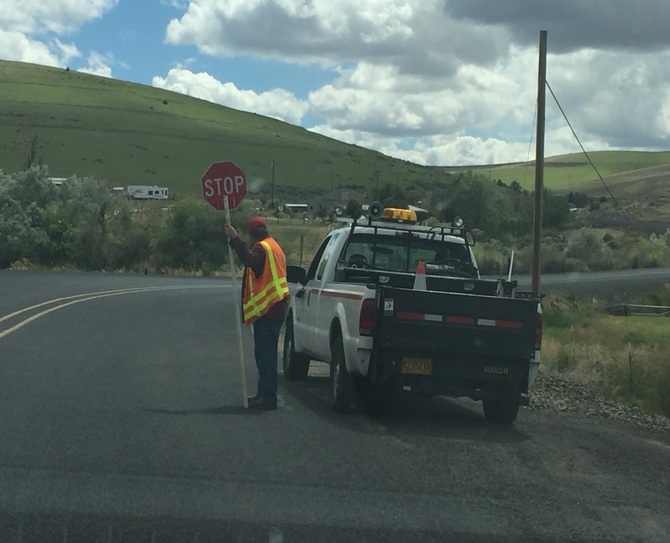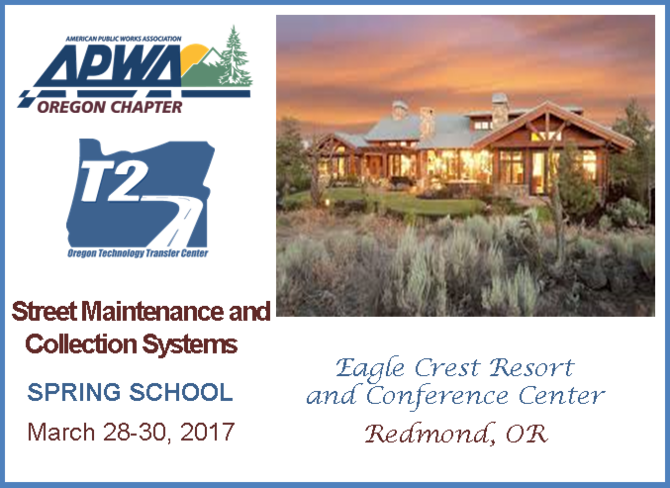 Maintaining constant awareness of the many potential hazards on the jobsite is difficult even when you are refreshed and focused. It can be nearly impossible to maintain if you are drowsy or distracted. Working while extremely tired and sleepy can be as dangerous as working while drunk. As more work is being done at night or extended weekend shifts, the potential for worker fatigue increases. Fatigue can accumulate over time and continue to desensitize you to risks.
Distractions can also keep you from maintaining risk awareness on the job. Your cell phone or smart device is one of the biggest distractors. While most agencies prohibit use of personal devices while working, more and more equipment and work tasks rely on workers utilizing these devices for job duties. Use of such devices reduces work accuracy and increases reaction times. In fact, someone using one of these devices can actually experience “risk blindness,” where hazards that are normally very visible are not even noticed. More information about worker fatigue and distraction effects and countermeasures can be found here. Examples of some policies regarding the use of electronic devices on the job can be found here.
To combat the risks of worker fatigue and distraction due to electronic devices, a new awareness and training initiative has been developed. The theme of this initiative as ALERT & ALIVE. The premise is that, unlike video games, where players can be virtually reborn after being killed, there are no “do-overs” if an accident occurs at a real-world jobsite. Tips for reducing risks on the job from being fatigued or distracted with electronic devices have been incorporated into
posters and tip cards that can be accessed below for those agencies and companies that want to print their own. In addition, two short (20-minute) on-line training modules have been developed, one for workers and one for managers and supervisors. These modules illustrate how fatigue and distraction affect safety on the jobsite, and educate the viewer on ways to mitigate those effects.
Reprinted from workzonesafety.org.
|

Did you know that the Oregon T2 Center will provide training customized to your needs? Whether it is training on a specific piece of equipment, driving techniques, roadside hazards, communication, or something completely different, feel free to give us a call. We have a large resource of experts that we can tap into for custom trainings or to answer questions. A few of the trainings we have offered by request in the past are:
- Mower safety
- Hands-on pneumatic roller safety
- Pavement rolling techniques
- Bucking fallen trees
- Chainsaw safety
- Winter driving
- Defensive driving for maintenance workers
- Bucket truck operator training
- Winter equipment readiness
- Winter road operations
- Deicing and snow removal
- Chip seal
- Hazard communication
- Incident stress
- Dealing with angry motorists/angry citizens
- Communicating with the public
- Generational differences
- Highway safety features
- Workplace safety
- Workplace conflict
- Road maintenance BMPs
If there is training or resources you are looking for, feel free to give us a call and we will be happy to tap into our experts or find the expert you need.
|


Two significant changes to the Oregon Commercial Driver License rules took effect September 26, 2016. Those changes are:
- Drivers who were trained and tested using an automatic transmission may only legally drive an automatic transmission vehicle. However, drivers trained and tested using a manual transmission vehicle may legally drive either a manual or automatic transmission.
-
Drivers trained and tested using a pentle hook may only legally tow using the same system. However, drivers trained and tested using a 5th wheel system may legally tow using either a 5th wheel or pentle hook.
These changes only apply to drivers licensed on or after September 26, 2016.
|
 As transportation agencies and their partners learn about the 11 innovations in Every Day Counts round four (EDC-4), they are evaluating which would best meet each State’s needs and requirements.
The following are the EDC-4 innovations States are considering for deployment in 2017 and 2018:
Automated traffic signal performance measures modernize traffic signal management by providing high-resolution data to actively manage performance and improve safety and customer service while cutting congestion and costs.
The effort on collaborative hydraulics: advancing to the next generation of engineering (CHANGE) uses hydraulic tools to improve understanding of complex interactions between river or coastal environments and transportation assets, enabling better design and more efficient project delivery.
Community connections are performance management approaches for planning, designing, and building transportation projects that promote connectivity, revitalize communities, and improve public health and safety.
Data-driven safety analysis uses tools to analyze crash and roadway data to predict the safety impacts of highway projects, enabling agencies to target investments with more confidence and reduce severe crashes on roads.
e-Construction and partnering: a vision for the future involves using paperless technologies to enhance partnering among stakeholders on construction projects, improving communication and workflows while streamlining project delivery.
Integrating the NEPA and permitting processes seeks to transform how agencies and stakeholders conduct concurrent, synchronized environmental and permitting reviews, saving time and cost for the agencies involved.
Pavement Preservation (When, Where, and How): Applying a pavement preservation treatment at the right time (when), on the right project (where), with quality materials and construction (how) is a critical investment strategy to help meet performance expectations. This innovation helps deploy an array of different analyses, treatments, and construction methods to help infrastructure owners achieve and sustain a desired state of good road repair despite tight budgets.
Road Weather Management – Weather-Savvy Roads: Weather events lead to traffic delays, reduced operational effectiveness, and increases in crashes. This innovation deploys two distinct road weather management solutions: (1) Pathfinder, which brings together DOTs and the National Weather Service to provide consistent messaging on adverse weather and road conditions and (2) advanced vehicle-based technologies, also referred to as integrated mobile observations. These two solutions have the potential to be transformative, by enabling State and local agencies to be proactive when it comes to weather, so they can manage the road system ahead of heavy rain, snow, or other storms.
Safe Transportation for Every Pedestrian (STEP): Pedestrians account for an estimated 15 percent of all roadway fatalities, the majority of which are at uncontrolled crossing locations (such as non-intersections) or at intersections with no traffic signal or STOP sign. This innovation helps transportation agencies address such crashes by promoting cost-effective countermeasures with known safety benefits.
Ultra-High Performance Concrete Connections for PBES: Prefabricated bridge elements and systems (PBES) offer superior durability and speed the onsite construction of bridges. The durability of prefabricated spans and how quickly they can be constructed is dependent on the connections between the elements. Ultra-high performance concrete can be used to help provide simple, strong, and durable connections for prefabricated bridge elements.
Using Data to Improve Traffic Incident Management: A TIM program is the systematic, planned, and coordinated use of human, institutional, mechanical, and other resources to shorten the duration and impact of incidents on U.S. roadways, and improve the safety of motorists, crash victims, and incident responders. This innovation focuses on improving the adoption and consistency of the collection of TIM data and increasing the volume of data from transportation, law enforcement, and other responder agencies. Further, this innovation promotes the use of low-cost, off-the-shelf technologies that streamline data collection, so agencies can measure and improve the performance of their programs.
In the coming months, EDC Newswill take a closer look at each EDC-4 innovation and FHWA resources available to help with deployment.will take a closer look at each EDC-4 innovation and FHWA resources available to help with deployment.
View introductory webinars on the EDC-4 innovations.
 |
|
To help Roads Scholars keep track of their completed training, we have produced wallet-sized, folded tracking cards that can be used to log Roads Scholar training classes as they are completed. Contact the T2 Center to get your tracking card! |
Left to Right: Ty Combs, Danny Byrd, and Dylan Jackson are presented their Roads Scholar Certificates by David Abbas, Streets and Operations Director.
 Sam was “separated” from the construction company where he had worked for 19 years. His attitude had become very difficult to work with, and the company had lost a few workers who said part of why they were leaving the company was due to the company’s apparent inability to address Sam and his “spirit of meanness.”
The contractor had tolerated Sam for many years, admitting that he knew that Sam was difficult for most employees to work with but that he was one of the best at his job. After the contractor’s HR director warned him as to the seriousness of the situation, Sam finally was put into a discipline process and was separated from the company two weeks later. All the documentation was appropriately completed.
Sam caught on with another contractor within two weeks, a competitor to his previous employer. Within the span of about 30 days Sam had essentially spread his anger at his termination to anyone who would listen. The worst part was that he went out of his way to call up a customer of his previous employer and spread his angry thoughts and comments to the owner. Sadly, this same customer was influenced enough in what Sam had shared that he informed Sam’s former company that it would not be considered for the next job or any other job coming up.
It’s easy to read this situation and wonder what took the contractor so long to finally deal with “Sam.” And true enough, when I was asked by the contractor to assist with the “recovery” strategy, Sam should have been terminated five to six years earlier. His negative and very demeaning behavior had thrived for that long. Sadly, the contractor had lost several good workers due to Sam’s influence and almost bullying tactics. Read more at ForConstructionPros.com
|

Sleep and Sleep Disorders
Contributed by Bill Kolzow
 Because sleep is so important to all of us, we need to make good sleep a top priority in our everyday lives. Our moods, performance, relationships, and health depend on sleep. We should view it as just as important as exercise and a healthy diet.
Good sleep can be disrupted by many things, such as anxiety or stress, pregnancy, family difficulties, general lifestyle, and so on. We are all exposed to some or all of these at times, and each of us reacts in our own way to them. At the same time, there are many sleep disorders that a person may be dealing with. One of the most common disorders is insomnia. More than half of adults report one or more symptoms of insomnia at least a few nights a week. It’s also very common among adolescents. Insomnia can also be a symptom of some other disorder or condition.
Some insomnia indicators are (1) difficulty falling asleep, (2) frequent awakening, (3) early awakening, or (4) a combination of these.
Some common factors that contribute to insomnia are:
- Medical illness
- Psychiatric illness
- Acute medication effects
- Medication withdrawal effects
- Other sleep disorders (and they are numerous)
- Poor sleep environment
- Poor sleep habits
- Situational factors (stress, bereavement, jet lag, etc.)
If your insomnia indicators last for more than a few nights to a couple weeks, it may be time to seek professional assistance.
Remember the need for a consistent good night’s sleep.
|
 As the first year of our Safety Circuit Rider program draws to a close, we want to update you on results and let you know what the new year holds for the program – and for you.
The purpose of the Safety Circuit Rider program is to help Oregon’s local agencies identify roadway safety concerns, analyze the benefits of various safety improvements, find potential funding sources, and coordinate with other parts of ODOT for help in implementing the solutions.
In his first year as our Safety Circuit Rider, Michael Swan has been able to meet with many of you and assist in informal roadside safety assessments. He has also helped to review safety data and is currently working on a project to help 21 counties determine safe operating speeds on collector and arterial roads – a mandate in the Manual on Uniform Traffic Control Devices.
Next year, Michael plans to meet with even more of you and help to address any roadway safety concerns you may have. To contact him, email him or call the T2 Center at (503) 986-2855.
|
 The Flexible Pavement Preservation Treatment Series provides participants with an introduction to the Pavement Preservation Treatment Construction Guide (PPTCG) so that they can use it to better familiarize themselves with general information on pavement preservation concepts and techniques.
The Maintenance Training Series trains individuals responsible for the maintenance of our nation's roadways. The series includes information on various maintenance operations topics, ranging from the conceptual to the practical.
TC3's curriculum is constantly being updated with new and revised content in order to provide the most accurate and educational learning experience possible. Continue reading for an overview of the module topics in these series.
Flexible Pavement Preservation Treatment Series
The Pavement Preservation Treatment Construction Guide (PPTCG) covers basic pavement preservation concepts as well as information on specific treatments to extend the life of asphalt pavements.
This training series is ideal for highway construction and maintenance teams, specifically the highway workers and inspectors involved in the placement of pavement preservation treatments. Design engineers will also benefit from the online guide and the associated training.
There are 11 modules in the series:
- Introduction to Pavement Preservation: The basics of pavement preservation including pavement structure, distresses, and differentiating pavement preservation from preventive maintenance
- Materials: The materials used for preventive maintenance treatments including materials comprising maintenance treatments, emulsions, and aggregates
- Crack Sealing and Filling and Joint Sealing: Crack sealing, crack filling, and joint sealing of flexible and rigid pavements—working and non-working cracks, fatigue and longitudinal cracks, correct temperatures for crack sealant, crack repair sequence, hot sealant, and crack sealing or filling criteria
- Localized Pavement Repairs: Pothole formation and edge failure, seal or fill decisions, construction of and problems with pothole patching, dig outs, edge repairs, skin patching, and capabilities and limitations of localized repairs
- Chip Seals: Project selection, pavement and weather condition requirements, storage, traffic control, construction sequence, aggregate spreading distance, brooming, chip spreading process, distributor preparation, and troubleshooting
- Fog Seals: Uses of fog seals, suitable pavement surfaces, storage and handling of materials, application process, and problems and causation
- Slurry Seals: The reasons to use slurry seals, gradations of slurry seal aggregate, preparation and application process, and problems and solutions
- Micro-Surfacing: Pavement and traffic condition considerations, construction, and troubleshooting
- Thin Functional HMA Overlay: Thin functional hot-mix asphalt (HMA) overlays including proper usage, suitable pavement conditions, construction, and troubleshooting
- Ultra-Thin HMA Bonded Wearing: Usage, distresses, application considerations, construction, and troubleshooting
- Selecting the Right Treatment: How to select the appropriate pavement preservation treatment(s) after analyzing given pavement and traffic conditions
View Series
Maintenance Training Series
This training series is designed for those who manage operations programs and deal with oversight and quality assurance across broad geographic areas. Courses assist those involved with handling materials, scheduling, budgeting, and planning.
There are 11 modules in this series:
- Pavement Preservation Program: Basic information on what comprises a pavement preservation program and how it is implemented with particular emphasis on changes in practice and the assignment of dedicated funding
- Shaping and Shoulders: Maintenance of both paved and unpaved shoulders, including specific details on the maintenance of gravel shoulders, in order to meet transportation agency goals of proper and timely shoulder maintenance
- Thin HMA Overlays and Leveling: Characteristics and purposes of thin hot-mix asphalt (HMA overlays) as well as the placement of leveling courses—common pavement treatments and often a central part of a maintenance crew's activities
- Base and Subbase Stabilization and Repair: Determining if the base or subbase must be stabilized or repaired, selecting the appropriate stabilization and repair methods for a given project, and ensuring the repair is performed properly
- Roadway Drainage: The purpose, function, and components of roadway drainage systems with a review of the components of shoulders and ditches, the purpose of a roadway drainage inventory, and the permits used in roadway drainage maintenance
- Outdoor Advertising: Rules and regulations governing placement and control of outdoor advertising along highway rights-of-way to ensure compliance with the standards stipulated in the Highway Beautification Act
- Roadside Vegetation Management: The need for, and purpose of, good vegetation management—equipment and herbicides used
- Weather-Related Operations: Planning requirements for an effective storm response, including scheduling and training personnel, identifying equipment needs, executing dry runs, and the additional requirements posed by a multi-day storm event
- Basics of Work Zone Traffic Control: Reviews fundamental concepts of setting up work zones, including proper signage, taper lengths, and flagging procedures through a series of work zone scenarios using Part 6 of the Manual on Uniform Traffic Control Devices (MUTCD)
- Underground Storage Tanks: Procedures to install, operate, and remove underground storage tank (UST) systems that store petroleum and other hazardous materials
- Cultural and Historic Preservation: Regulations and concerns related to safeguarding cultural and historic sites from the potential impacts of highway maintenance activities
View Series
In this picture, the flagger’s vehicle is parked too close to the flagging station. A flagger should always have an escape route that allows the ability for the flagger to quickly move away from the travel lane should an errant vehicle encroach on the flagging station.
The flagger’s vehicle also should be parked at least 100 feet from the flagging station.
In addition, the flagger should be holding the stop/slow paddle in their right hand and signaling traffic flow with their left.
 Asbestos Safety
The 14 minute video addresses the major areas needed to comply with OSHA regulations, including: hazards of asbestos, OSHA’s Asbestos Standard, composition and nature of asbestos, types of materials that may contain asbestos and where they are encountered, how to protect yourself when disturbing a material that may contain asbestos, and air monitoring and decontamination. © National Safety Compliance 2015.
Confined Spaces in Construction
The 20 minute video addresses the major areas needed to comply with the standard, including: contents of the OSHA standard (1926 Subpart AA), definition of confined spaces, hazards of confined spaces, training for entrants, attendants and supervisors, acute and chronic effects, permit-required confined spaces, emergency rescue, and PPE. © National Safety Compliance 2015.
Crane Safety: Hand Signals
The 13 minute video addresses the major areas needed to comply with the OSHA regulations, including: when a signal person is required, responsibilities of the signal person, and hand signals. © National Safety Compliance 2014.
Crane Safety: Rigging
The video addresses the major areas needed to comply with OSHA regulations, including: pre-lift safety measures, hazards, rigging equipment, hitches and sling angle, rigging practices, and lifting and landing the load. © National Safety Compliance 2014.
Excavation and Trenching
The 15 minute video addresses the major areas needed to comply with the OSHA regulations, including: contents of the OSHA standard 1926.650-652, hazards, competent person, safety precautions, access and egress, excavated materials (spoil), confined spaces, mobile equipment, surface crossing. © National Safety Compliance 2009.
Fall Protection
The 23 minute video addresses the major areas needed to comply with the standard, including: standard railing, safety nets, covers, Personal Fall Arrest Systems (PFAS), ABCs of PFAS, required fall protection, falling object hazards, training. © National Safety Compliance 2009.
Hearing Conservation
The video 26 minute addresses the major areas needed to comply with the OSHA Hearing Conservation Standard, including: the ear, hearing loss, definitions, types of hearing loss, effects of excessive noise exposure, evaluating noise exposure levels, hearing conservation program, hearing protection. © National Safety Compliance 2011.
Heat Stress Safety
Many workers are exposed to extreme heat conditions during the course of their workday and are at risk of heat stress. Exposure can lead to illness, injuries, and even death. Extreme heat can also increase the risk of workers injuring themselves and others due to not being able to perform their work duties safely. This training program will look at the different components of heat stress to help you understand the hazards and dangers associated with heat stress and educate you on ways to prevent it and protect yourself from illness and injury. 20 minutes, © National Safety Compliance 2014.
Introduction to Crane Safety
The video addresses the major areas needed to comply with OSHA regulations, including: ground conditions, power line safety, inspections, safety devices and operational aids, operation, signals, and maintenance and repair. 17 minutes, © National Safety Compliance 2014.
Slips, Trips and Falls
The video is 14 minutes and addresses the major areas needed to comply with OSHA regulations, including: same level falls and elevated falls, definitions, prevention, walking on wet surfaces, falling correctly, and accidents. © National Safety Compliance 2009.
|
FHWA Data-Driven Safety Analysis: High-Level Overview Video (8 minutes)
Data-Driven Safety Analysis is the application of the latest generation of tools for analyzing crash and roadway data. This video gives an overview of this approach, which enables safety professionals to make more informed safety management and project development decisions in order to better target highway safety investments and reduce the number of severe crashes on roadways. https://www.youtube.com/watch?v=Lx7sJktkFVA&feature=youtu.be
Road Safety Culture Video (12 minutes)
The National Center for Rural Road Safety has released its first training video, "Introduction to Road Safety Culture." Produced expressly for State, local, and tribal agencies that manage rural roads, the video introduces the concept of road safety culture and explains how it affects behaviors of drivers. National expert Dr. Nicholas Ward of Montana State University presents methods that can be used to understand the safety culture that exists in a given community, and describes examples of successful initiatives to apply this information toward public outreach campaigns that encourage safer driver behavior. To view the video, visit the Safety Center website at: http://ruralsafetycenter.org/resources/multimedia or go to https://youtu.be/KCMxAktDsE0.
Avoiding Fatalities Video Series
NIOSH’s Fatality Assessment and Control Evaluation (FACE) Program is a research program designed to identify and study fatal occupational injuries. The goal of the FACE program is to prevent occupational fatalities across the nation by identifying and investigating work situation at high risk for injury and then formulating and disseminating prevention strategies to those who can intervene in the workplace. More FACE reports can be found at http://www.cdc.gov/niosh/face/.
Available are series of animated videos following on-site investigations during work zone accidents and incidents. The videos follow the course of the accident and subsequent fatality and provide recommendations designed to control or eliminate the identified risk. These animated videos were created by ARTBA as a part of a FHWA and the OSHA Cooperative Agreement. https://www.workzonesafety.org/data-resources/niosh_face_videos/.

|